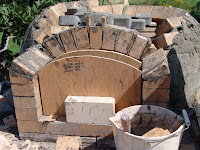
I remember my first big gas grill. I felt like Captain Kirk on the bridge of the Starship Enterprise. A console of space-age chrome and futuristic knobs awaited my command. I could sear six steaks or a slab of salmon at warp speed. The grill left the trademark grill-lines in the meats and the smell of burning fat wafted upwards. It was a good facsimile.


Like the arrival of white bread to universal praise in early 20
th century homes, the gas grill heralded a new, less earth-bound era. Gone were the unpredictable and annoying skills of lighting the charcoal briquettes and getting an even burn.
So when did I lose the thrill? When did I fully come to grips with the disappointment of rusted grill bars and dysfunctional burner ports? When did I stop looking forward to hauling the canisters to the propane dealer?
I am a landscape designer and stonemason. Real materials, as old, and older than life on this planet, are my design elements. I enjoy growing a vegetable garden. I love fresh-baked bread and know how to make it. I like pizza as do most Americans.
The grill died, transfer-station dead. I had a stack of firebricks, I had a mason’s skills and tools, and I had a plan. A true brick oven, the kind used for centuries throughout the world, could be mine for the effort.
We look back on our lives and mark the pivotal moments: kindergarten, first love, first car, first job, marriage, children, owning a house (not necessarily in that order).
For anyone who likes to cook, a brick oven will be a pivotal moment, akin at least to a first car.
It is the ultimate cooking ‘appliance’. It can roast, bake, grill, broil, slow-cook, fast cook (pizza in 2 minutes) all on one firing with very little firewood. But it is not a food processor. You will find yourself looking forward to using it. You will sit next to it. You’ll admire the flames curling under the domed ceiling, the age-old magic of wood and brick. Cooking will become ceremonial.

It is a social event. The oven itself becomes the focal point of a gathering, providing both exquisite food and a bright flame. No longer do I have to lure friends to a party with promises I can’t personally fulfill (“it’ll be a great time”). I just have to fire up the oven and the event takes off. I’ve seen people giggling over making their own ‘dream’ pizza from a table full of ingredients. I get together with fellow bread-bakers and we shape and sample a dozen artisan breads, dipped in olive oil, slathered with butter, or just torn from the warm loaf. I have cooked an entire Thanksgiving dinner in my brick oven; popovers to pudding.

Whether the oven is outdoors, in a three-season room, or part of the kitchen, a brick oven is a timeless object. A brick oven will connect you to cultural roots you may not even know you have.
Like Rip Van Winkle waking from a centuries-long sleep, you will gaze at your gas grill as if you’d never seen anything so strange. The brick oven will appear as if it has been part of your life forever, and it has. All of our ancestors cooked in these. In Europe, Asia, the Middle East, Latin America, Scandinavia, Africa, North America, with small differences, people have made their food in brick ovens.
The experience awaits us, forward, into the past.


























